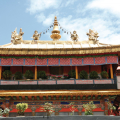JOKHANG TEMPLE
It is the most revered sanctuary in Tibet, in the heart of the old town. Columns of pilgrims lie there continuously and their fervor feeds the already sacred atmosphere of the place.
The foundation of Jokhang. Weng Cheng, Chinese wife of Songtsen Gampo, and daughter of a Taizong emperor's concubine, practiced geometry (feng shui, literally wind and water), science still in use in China. It is she who, through his calculations, detects the presence of a demonic (sinmo) lying on his back and whose body covered all central Tibet. In order to stem her negative influence on the country, it had to be submitted by constructing four temples at the suspected places of his shoulders and hips: Katsel, Trandruk, Dram and Butchu. The three hills surrounding Lhasa (Marpori, Chakpori, Bompori) were her breasts and his mount of Venus. At the heart of the heart was a lake, the blood of the devil. This is where the Tsuklakhang (Jokhang) was erected. Tsuklag is an ancient term that refers to religious science which includes both shamanism, astrology and geometry.
The lake was filled with a magic goat, and it was built instead of the Jokhang, intended to house the statue of the Akshobya Buddha, made in dowry by Brikuti.
The sanctuary then took the name of Trulnang. He became the Jokhang only when he housed the Jowo, who had been hidden in the chapel of Medical Buddhas, during an invasion. The Jowo, brought in dowry by the Chinese princess, was a gift from the King of Bengal to the Chinese emperor and the work, apparently, of the artist Vishvakarman, contemporary of the Buddha. The exchange of statue was made and the temple of Ramoche, originally built for Jowo, now houses the Akshobya Buddha.
In front of the main entrance there are three stalls, now surrounded by a wall: one includes a bilingual inscription referring to the Sino-Tibetan treaty of 821, concluded between Tri Ralpachen and the Chinese Emperor Wangdi, and by which each country undertook to respect the other as its equal. The other two, polite by being affected, inform in Chinese the dangers of smallpox and the means of healing it.
Visit of Jokhang. First enters an interior courtyard decorated with paintings under the 13 th Dalai Lama. The Dalai Lama's apartments dominate the courtyard. Two large doors allow access to the holy saints. In the dark, we see first and foremost the Guardians of the four directions, and then two chapels dedicated to the Nagas, the marine deities that hold wealth, and the Gandarvas, the spirits that feed on odors. They were told that they would have appeared in contemplation of Songtsen Gampo during the construction of the Jokhang, and that they wanted to dedicate them to both sanctuaries.
Work of Newar artists, the temple was originally open in open skies like the Nepalese bahal. The massive pillars are of origin, but the capitals date back to the seventeenth century. Most statues were destroyed during the Cultural Revolution and the ancient frescoes were unfortunately varnished.
The whole lower part of the Jowo body was destroyed during the invasion of the Dzoungars in the eighteenth century. However, his sanctuary remains the strongest moment in the pilgrimage for any Tibetan who advance, gathered, ready to offer his khata and express his wishes. The two great statues of Guru Rimpoula and Maitreya are president of the rituals, while a succession of small obscure chapels indicate the pilgrim's route to the pilgrims with its offerings.
Climb on the roof to make photos of the Potala in the morning. You will take advantage of the golden makaras, mythical animals to the truncated elephant tube, which protect from lightning, terror of wooden temples. You will also see the eight-ray wheel of the doctrine (Dharma), framed by the two gazelles symbolizing the park where the Buddha gives its first teaching. You will notice, on the four corners, the aspen of golden metal victory or covered with yack black wool and overcome with a trident. It is also in the upper gallery of the temple that the monks indulge in surprising rhetoric in the afternoon.
Did you know? This review was written by our professional authors.
Book the Best Activities with Get Your Guide
Members' reviews on JOKHANG TEMPLE
The ratings and reviews below reflect the subjective opinions of members and not the opinion of The Little Witty.

